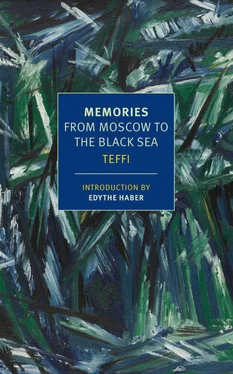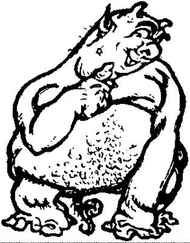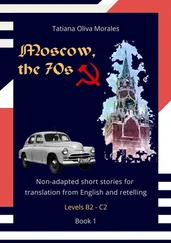Alexey Grishin-Almazov (1880–1919) was, during much of 1918, in command of the White armies in western Siberia. He then moved to the south of Russia. In December 1918, the French, then in control of Odessa, appointed him military governor.
Vladimir Burtsev (1862–1942) was a historian and journalist who served time in prison under both the tsarist and Soviet regimes. His newspaper The Common Cause went through several different incarnations: in 1909–10, 1917, 1918–22 and 1928–33.
A once-famous novel by Semyon Yushkevich (1868–1927). It is set largely in Odessa.
An infamous Odessa gangster, Jewish revolutionary, and Soviet military leader.
The Moldavanka was a poor part of Odessa, with a reputation for criminality. The writer Isaak Babel was born there, and it provides the setting for his “Odessa Tales,” a cycle of stories about the life of Jewish gangsters.
This paragraph is, in effect, a condensed version of “The Last Breakfast,” the last article Teffi published in Odessa. See appendix, p. 231.
Fyodor Blagov (1886–1934), the last editor of the Russian Word , emigrated to China, where he worked for Russian newspapers in Harbin and Shanghai.
Maximilian Voloshin (1877–1932) was a leading figure among the Russian Symbolist poets of the early twentieth century. For over a decade his large house in Koktebel, where he both wrote and painted, was a refuge for writers and artists of all political and artistic persuasions. Among his hundreds of guests were Maxim Gorky, Nikolay Gumilyov, Osip and Nadezhda Mandelstam, and Marina Tsvetaeva. In 1924 the house became a “House of Creativity” for Soviet writers, the first of the many such closed-access hotels that were a central part of the Soviet cultural world. In spite of a number of facile professions of faith in Russia’s purification through suffering, Voloshin’s poems about the Civil War and the subsequent Red Terror in the Crimea are courageous and incisive. Voloshin was steadfast in his refusal to accept any ideology as absolute truth. A poem titled “Civil War” ends:
And from the ranks of both armies
I hear one and the same voice:
“He who is not with us is against us.
You must take sides. Justice is ours.”
And I stand alone in the midst of them,
amidst the roar of fire and smoke,
and pray with all my strength for those
who fight on this side, and on that side.
Voloshin’s belief in the power of his words—what Marianna Landa refers to as “his Dostoevskian faith in the divine spark in the soul of the abominable criminal, and his Symbolist belief in the magic of the poetic word”—seems to have been unshakeable; his personal appeals to Red and White officials and commanders, on behalf of individuals in trouble, and his verse-prayers addressed to God, on behalf of his country, have much in common. Voloshin believed he could affect the course of events—and sometimes he did. That he escaped arrest and execution is astonishing. See The Penguin Book of Russian Poetry (Penguin Classics, 2015, ed. Robert Chandler, Boris Dralyuk, and Irina Mashinski), pp. 175–180. For a somewhat more critical view of Voloshin, see Ivan Bunin, Cursed Days , pp. 82, 112. Much about Voloshin evidently enraged Bunin. In a diary entry for April 16, 1919, he writes, “Voloshin visited us […] It was monstrous! He said he had spent all day with Severny, the head of the local Cheka, who has a ‘soul like crystal.’ That’s just what he said: ‘like crystal.’”(ibid. p. 85) Nevertheless, Bunin’s wife writes in her own diary, September 6, 1919, “Valya [Kataev] lashed out at Voloshin. For some reason he can’t stand him. [Bunin] defended Voloshin, saying that though his verse is wordy, something genuine and personal shines forth from it. ‘There are too few Voloshins around for you to be negative toward him. How well Voloshin has sung of his country. How very good are his portraits.’” (Thomas Gaitan Marullo, Ivan Bunin: Russian Requiem [Ivan Dee, 1993!], p. 346.)
Grigory (or Grishka) Otrepyev, popularly known as “The False Dmitry,” was a monk who claimed to be Dmitry, the murdered son of Ivan the Terrible. He reigned for eleven months during 1605–6.
Yelizaveta Kuzmina-Karavayeva (1891–1945) was elected deputy mayor of the southern Russian town of Anapa in 1918. When the Whites captured the town, she was put on trial as a Bolshevik but acquitted. Her judge, Daniil Skobtsov, who had once been her teacher, then married her; their marriage (her second) fell apart in the late 1920s, but her writings are often published under her married name of Skobtsova. In 1932, in Paris, she took monastic vows, assuming the name of Mother Maria. During World War II she helped many Jews to escape the Nazis, often by providing them with baptismal certificates, but she was eventually sent to the Ravensbrück concentration camp. In March 1945, a week before the camp was liberated by the Red Army, she was sent to the gas chamber; according to one testimony, she voluntarily took the place of a Jewish woman. In 2004 she was canonized as a saint by the Orthodox Patriarchate of Constantinople. See also The Penguin Book of Russian Poetry , pp. 188–89 and p. 547, note 22.
In the Russian Orthodox Church a metropolitan is a high-ranking clergyman, senior to an archbishop and second only to a patriarch.
Admiral Alexander Kolchak (1874–1920) established a right-wing government in Siberia in late 1918 and was recognized as Supreme Commander by the other leaders of the White forces, not only in Siberia but also in the south of Russia.
In June 1917, mutinous sailors of the Black Sea Fleet decided to confiscate their officers’ weapons. Rather than surrender his ceremonial cutlass, Kolchak threw it into the sea. It was later returned to him, with a respectful message.
Teffi’s first books, both in fact published several years before the beginning of the War, were two volumes titled Humorous Stories , in prose, and Seven Fires , in verse. The latter is divided into seven sections: “Sapphire,” “Amethyst,” “Alexandrite,” “Ruby,” “Emerald,” “Diamond,” and “Topaz.” The poet Nikolay Gumilyov reviewed Seven Fires enthusiastically, describing the poems as “literary in the best sense of the word” and referring to the “mask that Teffi wears with a solemn grace and, it seems, with a barely noticeable smile.” Quoted in Nadezhda Teffi, Almaznaya Pyl’ , (Moscow, 2011) p. 8.
This stone was first discovered in April 1834, on the sixteenth birthday of the future Tsar Alexander II. Green or bluish-green in daylight, it turns a soft shade of red under incandescent light. “The bloody sunset” refers to the tsar’s assassination in 1881.
Alexander Yakovlev (1887–1938) was a painter and graphic artist. Like Teffi, he worked for both Satirikon and New Satirikon , as well as many other journals. In the summer of 1917, he went to study in the Far East. After traveling through Mongolia, China, and Japan, he settled in Paris. Teffi mentions his wife Bella Kaza-Roza in the first chapter of Memories (p. 9 and also note 9).
Friedrich Martens (1845–1909) was a Russian diplomat and lawyer who made important contributions to the field of international law. Valerie Sollohub, the widow of Martens’s grandson Count Nicholas Sollohub, writes, “I fear this story must be apocryphal. Professor Martens died in the daytime, in Livonia, on the railway station platform, unbeknown to his wife who was at their country house, Waldensee, with the telephone out of order. From the depths of the country she would not have been sending servants out with opals nor, indeed, was she inclined to buy precious stones; she left all that kind of thing to her husband.” (Personal email, May 2014. There is no knowing whether Konoplyov’s story is his own invention or Teffi’s.)
Читать дальше












